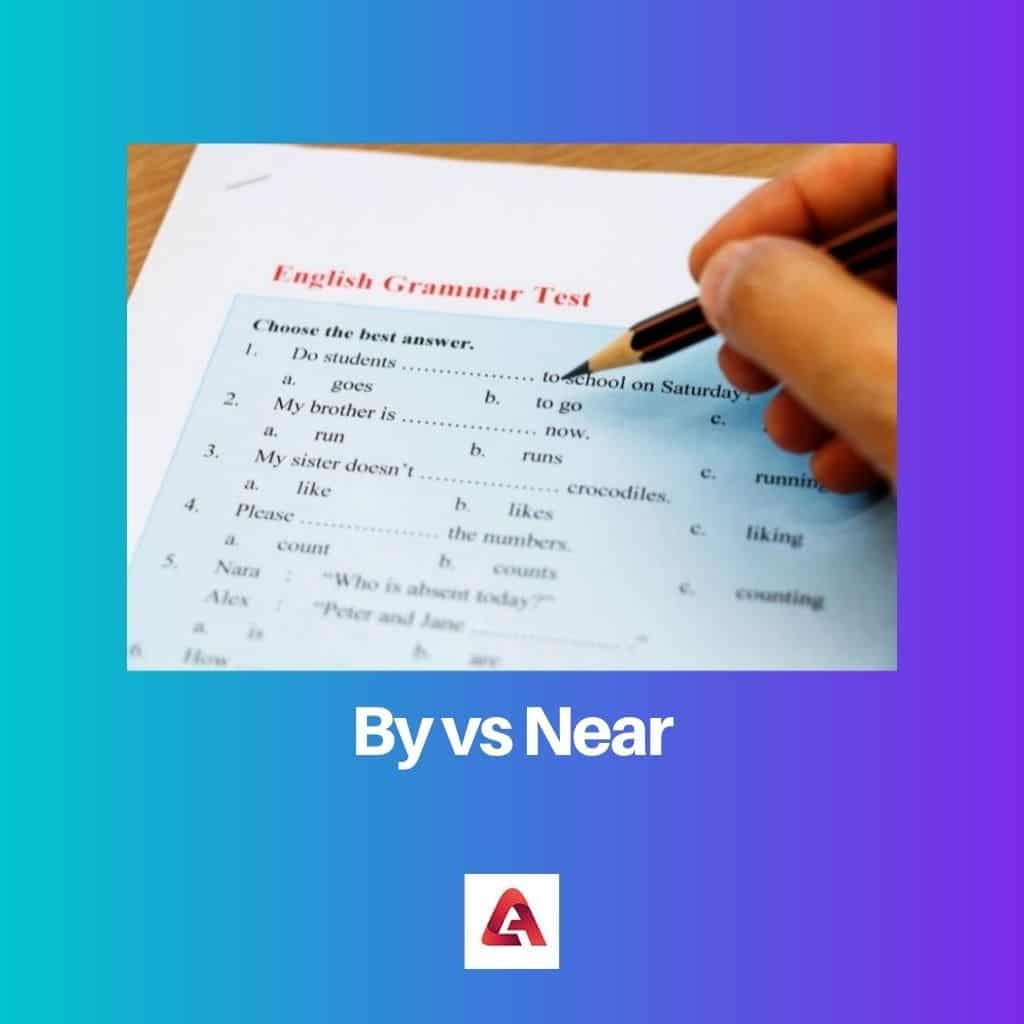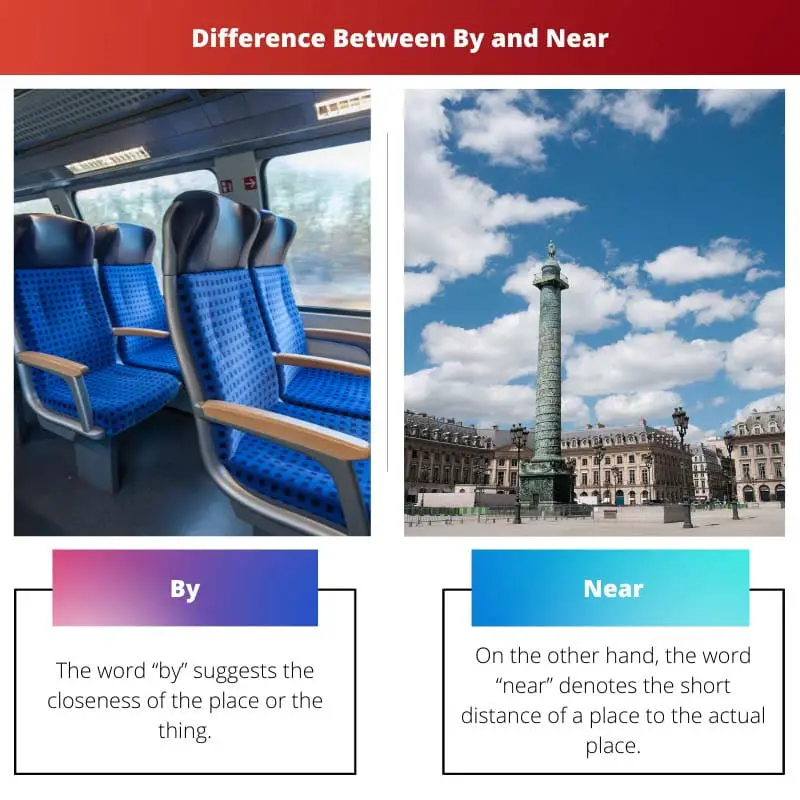“By” typically denotes proximity or adjacency, indicating something is immediately adjacent or next to another object or location. On the other hand, “near” suggests a relative closeness in distance, implying that something is nearby but not necessarily directly adjacent. While “by” implies direct contact or connection, “near” allows for a bit more leeway in distance, implying a spatial relationship without immediate adjacency.
Key Takeaways
- “By” is a preposition to indicate proximity or adjacency, while “near” is a preposition or adverb to denote closeness in distance or time.
- “By” can suggest a location immediately adjacent to or touching another location, whereas “near” implies a location that is relatively close but not necessarily touching.
- Both “by” and “near” are used to convey proximity but have slightly different implications: “by” suggests more immediate or direct proximity. In contrast, “near” implies a somewhat looser or more general closeness.
By vs. Near
“By” is a preposition that is used to indicate a sense of proximity next to, through, or near something or someone, and is used to indicate something that is used as a means to an end. “Near” is also a preposition that is used to indicate a sense of proximity or closeness to something or someone.

Comparison Table
| Feature | By | Near |
|---|---|---|
| Function | Primarily a preposition with various uses, including: * Denoting means or method: accomplish something by working hard. * Denoting agent: The work was done by her. * Denoting location (in proximity): He stood by the window. | Primarily a preposition denoting proximity or closeness in space, time, or degree. |
| Emphasis | Can emphasize the means, method, agent, or location. | Emphasizes closeness but not necessarily direct contact or adjacency. |
| Degree of Closeness | Can imply direct contact or adjacency (e.g., “stand by the window”). | Denotes a broader sense of closeness, not necessarily implying direct contact (e.g., “The house is near the lake”). |
| Examples | * The cake was made by my grandmother. (agent) * They traveled by train. (means) * I live by the park. (location) | * The store is near the corner. * I will be there near lunchtime. * The two ideas are near identical. |
When to Use By?
1. Proximity and Adjacency:
“By” is commonly used to denote proximity or adjacency, indicating that something is immediately adjacent or next to another object or location.
- Example: “The book is placed by the lamp on the table.” Here, “by” indicates that the book is positioned immediately next to the lamp.
2. Passing Through or Alongside:
“By” is used to indicate passing through or alongside a particular place or object.
- Example: “She walked by the park on her way home.” In this sentence, “by” suggests that she walked alongside or past the park while heading home.
3. Means or Method:
“By” can also signify the means or method through which something is done or achieved.
- Example: “He won the game by using his strategic skills.” Here, “by” indicates the method or means (strategic skills) through which he won the game.
4. Temporal Indication:
“By” is used to indicate a point in time at or before which something must be done or completed.
- Example: “Please submit your report by Friday.” In this context, “by” specifies the deadline by which the report must be submitted, suggesting any time before Friday.

When to Use Near?
1. Proximity and Spatial Relationship:
“Near” is primarily used to indicate proximity or closeness in terms of distance, suggesting that something is close but not necessarily directly adjacent.
- Example: “The store is near the post office.” Here, “near” indicates that the store is in close proximity to the post office, suggesting they are within walking distance of each other.
2. Relative Distance:
“Near” is used to describe a relative closeness in distance compared to another object, place, or point of reference.
- Example: “The hotel is near the beach.” In this sentence, “near” suggests that the hotel is located relatively close to the beach, but not necessarily right next to it.
3. Directional Indication:
“Near” can be used to provide directional guidance by indicating the proximity of one location in relation to another.
- Example: “The restaurant is near the city center.” Here, “near” provides information about the restaurant’s location in relation to the city center, indicating it’s in close proximity to that central point.
4. Alternative to “Close to” or “Next to”:
“Near” can be used as an alternative to phrases like “close to” or “next to” to describe spatial relationships.
- Example: “The playground is near the school.” This sentence conveys that the playground is in close proximity to the school, without necessarily implying direct adjacency.

Main Differences Between By and Near
- Spatial Relationship:
- “By” suggests direct adjacency or immediate proximity.
- “Near” implies closeness in distance but not necessarily direct adjacency.
- Directional Guidance:
- “By” often indicates passing through or alongside a specific place or object.
- “Near” provides directional indication by specifying proximity in relation to another location or point of reference.
- Temporal Indication:
- “By” is used to specify a point in time at or before which something must be done or completed.
- “Near” does not indicate time but rather spatial proximity.
- Means or Method:
- “By” can indicate the means or method through which something is done or achieved.
- “Near” does not imply any specific method or means but focuses solely on spatial proximity.
- Precision of Relationship:
- “By” implies a more precise relationship, often suggesting direct contact or connection.
- “Near” allows for a broader interpretation of spatial relationship, indicating closeness without specifying direct adjacency.
- Relative Distance:
- “By” indicates immediate proximity or adjacency.
- “Near” suggests relative closeness in distance compared to another object, place, or point of reference.





